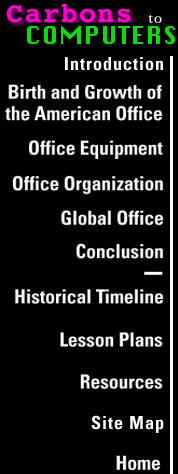
Lesson Plans
Lesson 3
Objective: To develop interviewing techniques--organize ideas and materials; record and summarize data; develop hypotheses about information collected; present results.
The photographs in this unit offer many views of office life in the past and present, but artifacts and images can only tell part of any story. In the following activity, students employ a research method used by historians: the interview. Explain to the class that the interview is a living primary source of information.
The purpose of the students' interviews will be to gather information about work and conditions in offices over the past several years. The activity will culminate in students' writing a two-page summary of their interviews. Recommend that students find people to interview who have worked in offices for at least fifteen years, preferably longer. People who have retired would be ideal candidates for interviews. Other potential subjects would be the school's business course instructors. Instructors would have knowledge of changes in machinery and equipment, necessary skills for office workers, changing proportions of women to men in their classes, career aspirations and achievements of their graduates, and much more.
To prepare for the interviews, give each student a copy of the Interview Worksheet and the Interview Checklist. In class, discuss possible additions to these lists and stress the lists' importance in organizing and completing successful interviews. Because interviews often generate more interesting information than can be presented in the interviewer's two-page summary, students will need to select and organize their findings with great care.
![]()
Lessons start page || Lesson 1 || Lesson 2 || Lesson 3 || Lesson 4